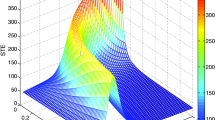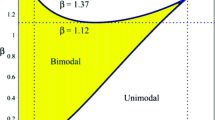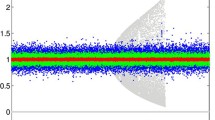Abstract
A susceptibility of population systems to the random noise is studied on the base of the conceptual Ricker-type model taking into account the delay and Allee effect. This two-dimensional discrete model exhibits the persistence in the form of equilibria, discrete cycles, closed invariant curves, and chaotic attractors. It is shown how the Allee effect constrains the persistence zones with borders defined by crisis bifurcations. We study the role of random noise on the contraction and destruction of these zones. This phenomenon of the noise-induced extinction is investigated with the help of direct numerical simulations and semi-analytical approach based on the stochastic sensitivity functions. Stochastic transitions from the persistence regimes to the extinction are studied by the analysis of the mutual arrangement of the basins of attraction and confidence domains.









Similar content being viewed by others
References
Adler PB, Drake JM (2008) Environmental variation, stochastic extinction, and competitive coexistence. Am Nat 172:E186–E195
Allee WC (1931) Animal aggregations, a study in general sociology. University of Chicago Press, Chicago
Allen LJS, Fagan JF, Högnäs G, Fagerholm H (2005) Population extinction in discrete-time stochastic population models with an Allee effect. J Differ Equ Appl 11:273–293
Alvarez L (2001) Does increased stochasticity speed up extinction? J Math Biol 43:534–544
Arditi R, Ginzburg LR (2012) How species interact: altering the standard view on trophic ecology. Oxford University Press, Oxford
Avilés L (1999) Cooperation and non-linear dynamics: an ecological perspective on the evolution of sociality. Evol Ecol Res 1:459–477
Bartha FA, Garab A, Krisztin T (2013) Local stability implies global stability for the 2-dimensional Ricker map. J Differ Equ Appl 19:2043–2078
Bashkirtseva I, Ryashko L (2014a) Stochastic bifurcations and noise-induced chaos in a dynamic prey–predator plankton system. Int J Bifurc Chaos 24:1450109
Bashkirtseva I, Ryashko L (2014b) Stochastic sensitivity of the closed invariant curves for discrete-time systems. Phys A 410:236–243
Bashkirtseva I, Ryashko L (2015) Approximating chaotic attractors by period-three cycles in discrete stochastic systems. Int J Bifurc Chaos 25:1550138
Bashkirtseva I, Ryashko L (2017) How environmental noise can contract and destroy a persistence zone in population models with Allee effect. Theor Popul Biol 115:61–68
Bashkirtseva I, Ryashko L, Tsvetkov I (2010) Sensitivity analysis of stochastic equilibria and cycles for the discrete dynamic systems. Dyn Contin Discrete Impuls Syst Ser A Math Anal 17:501–515
Bazykin AD (1998) Nonlinear dynamics of interacting populations. World Scientific, Singapore
Blasius B, Kurths J, Stone L (2007) Complex population dynamics: nonlinear modeling in ecology. World Scientific, Singapore Epidemiology and Genetics
Block GL, Allen LJS (2000) Population extinction and quasi-stationary behavior in stochastic density-dependent structured models. Bull Math Biol 62:199–228
Brauer F, Castillo-Chavez C (2001) Mathematical models in population biology and epidemiology, TAM 40. Springer, Berlin
Courchamp F, Berec L, Gascoigne J (2008) Allee effects in ecology and conservation. Oxford University Press, New York
Cushing JM, Costantino RF, Dennis B, Desharnais RA, Henson SM (2003) Chaos in ecology, vol 1. Academic Press, Boston Experimental Nonlinear Dynamics
De Roos AM, Persson L (2002) Size-dependent life-history traits promote catastrophic collapses of top predators. Proc Natl Acad Sci USA 99:12907–12912
Dennis B (1989) Allee effect: population growth, critical density and the chance of extinction. Nat Resour Model 3:481–538
Dennis B (2002) Allee effects in stochastic populations. Oikos 96:389–401
Dennis B, Assas L, Elaydi S, Kwessi E, Livadiotis G (2016) Allee effects and resilience in stochastic populations. Theor Ecol 9:323–335
Duarte J, Januário C, Martins N, Sardanyés J (2012) On chaos, transient chaos and ghosts in single population models with Allee effects. Nonlinear Anal Real World Appl 13:1647–1661
Dupont WD (1983) A stochastic catch-effort method for estimating animal abundance. Biometrics 39:1021–1033
Elaydi S, Sacker RJ (2010) Population models with Allee effect: a new model. J Biol Dyn 4:397–408
Gao JB, Chen CC, Hwang SK, Liu JM (1999) Noise-induced chaos. Int J Mod Phys B 13:3283–3305
Greenman JV, Benton TG (2005) The impact of environmental fluctuations on structured discrete time population models: resonance, synchrony and threshold behaviour. J Theor Biol 268:217–235
Guttal V, Jayaprakash C (2007) Impact of noise on bistable ecological systems. Ecol Model 201:420–428
Hart EM, Avilés L (2014) Reconstructing local population dynamics in noisy metapopulations—the role of random catastrophes and Allee effects. PLoS ONE 9:e110049
Hastings A (1996) Population biology: concepts and models. Springer, New York
Hastings A, Gross L (eds) (2012) Encyclopedia of theoretical ecology. University of California Press, Berkeley
Horsthemke W, Lefever R (1984) Noise-induced transitions. Springer, Berlin
Inoue J, Doi S, Kumagai S (2001) Numerical analysis of spectra of the Frobenius–Perron operator of a noisy one-dimensional mapping: toward a theory of stochastic bifurcations. Phys Rev E 64:056219
Jankovic M, Petrovskii S (2014) Are time delays always destabilizing? Revisiting the role of time delays and the Allee effect. Theor Ecol 7:335–349
Lai Y-C (2005) Beneficial role of noise in promoting species diversity through stochastic resonance. Phys Rev E 72:042901
Lande R, Engen S, Saether B-E (2003) Stochastic population dynamics in ecology and conservation. Oxford University Press, Oxford
Lasota A, Mackey MC (1994) Chaos, fractals, and noise: stochastic aspects of dynamics. Springer, Berlin
Lazaryan N, Sedaghat H (2016) Extinction, periodicity and multistability in a Ricker model of stage-structured populations. J Differ Equ Appl 22:519–544
Levin SA, May RM (1976) A note on difference-delay equations. Theor Popul Biol 9:178–187
Li J, Song B, Wang X (2007) An extended discrete Ricker population model with Allee effects. J Differ Equ Appl 13:309–321
Lidicker WZ (2010) The Allee effect: its history and future importance. Open Ecol J 3:71–82
Lindner B, Garcia-Ojalvo J, Neiman A, Schimansky-Geier L (2004) Effects of noise in excitable systems. Phys Rep 392:321–424
Liz E, Ruiz-Herrera A (2015) Delayed population models with Allee effects and exploitation. Math Biosci Eng 12:83–97
May R (1976a) Simple mathematical models with very complicated dynamics. Nature 261:459–467
May R (1976b) Theoretical ecology: principles and applications. Blackwell, Oxford
May RM (1987) Chaos and the dynamics of biological populations. Proc R Soc Lond A 413:27–44
McDonnell MD, Stocks NG, Pearce CEM, Abbott D (2008) Stochastic resonance: from suprathreshold stochastic resonance to stochastic signal quantization. Cambridge University Press, Cambridge
Melbourne BA, Hastings A (2008) Extinction risk depends strongly on factors contributing to stochasticity. Nature 454:100–103
Morozov A, Banerjee M, Petrovskii S (2016) Long-term transients and complex dynamics of a stage-structured population with time delay and the Allee effect. J Theor Biol 396:116–124
Murray JD (2002) Mathematical biology. I. An introduction. Springer, New York
Ovaskainen O, Meerson B (2010) Stochastic models of population extinction. Trends Ecol Evol 25:643–652
Pounder JR, Rogers TD (1980) The geometry of chaos: dynamics of a nonlinear second-order difference equation. Bull Math Biol 42:551–597
Quinn TJ, Deriso RB (1999) Quantitative fish dynamics. Oxford University Press, Oxford
Ricker WE (1954) Stock and recruitment. J Fish Res Board Can 11:559–623
Ridolfi L, D’Odorico P, Laio F (2011) Noise-induced phenomena in the environmental sciences. Cambridge University Press, Cambridge
Rogers TD, Clarke BL (1981) A continuous planar map with many periodic points. J Appl Math Comput 8:17–33
Roozen H (1987) Equilibrium and extinction in stochastic population dynamics. Bull Math Biol 49:671–696
Roth G, Schreiber SJ (2014) Pushed beyond the brink: Allee effects, environmental stochasticity, and extinction. J Biol Dyn 8:187–205
Schreiber SJ (2003) Allee effects, extinctions, and chaotic transients in simple population models. Theor Popul Biol 64:201–209
Smith JM (1968) Mathematical ideas in biology. Cambridge University Press, Cambridge
Spagnolo B, Cirone M, Barbera AL, de Pasquale F (2002) Noise-induced effects in population dynamics. J Phys Condens Matter 14:2247–2255
Stephens PA, Sutherland WJ, Freckleton RP (1999) What is the Allee effect? Oikos 87:185–190
Strogatz SH (1994) Nonlinear dynamics and chaos: with applications to physics, biology, chemistry, and engineering. Avalon Publishing, New York Studies in Nonlinearity
Turchin P (2003) Complex population dynamics: a theoretical/empirical synthesis. Princeton University Press, Princeton
Ufuktepe U (2014) Allee effects in population dynamics. Biomath Commun 1:12–19
van Voorn GAK, Kooi BW, Boer MP (2010) Ecological consequences of global bifurcations in some food chain models. Math Biosci 226:120–133
Wysham DB, Hastings A (2008) Sudden shifts in ecological systems: intermittency and transients in the coupled Ricker population model. Bull Math Biol 70:1013–1031
Acknowledgements
The work was supported by Russian Science Foundation (N 16-11-10098).
Author information
Authors and Affiliations
Corresponding author
Appendix
Appendix
As a mathematical model of many population systems, the following generalized discrete dynamic system is frequently used
Here, x is an n-vector and f(x) is a sufficiently smooth vector-function.
An influence of random factors can be studied on the base of the stochastic system
where \(\sigma (x)\) is \(n\times m\)-matrix, \(\xi _{t}\) is m-dimensional uncorrelated random process with parameters \({\mathrm E}\xi _{t} = 0, \; {\mathrm E}\xi _{t}\xi _{t}^\top =I,\; {\mathrm E}\xi _{t}\xi _{k}^\top =0 (t\ne k)\). Here, I is an identity \(m\times m\)-matrix. The scalar parameter \(\varepsilon \) defines an intensity of noise.
Under the random disturbances, around attractors of deterministic system (4), a stationary probabilistic distribution \(p(x,\varepsilon )\) of random states of system (5) is formed. For the approximation of this distribution in the presence of small noise, a method of stochastic sensitivity functions was proposed in Bashkirtseva et al. (2010) for equilibria and discrete cycles, and in Bashkirtseva and Ryashko (2014b) for closed invariant curves.
Stochastic sensitivity of the equilibrium
Let \(\bar{x}=f(\bar{x})\) be an exponentially stable equilibrium of system (4). The stochastic sensitivity matrix W of the equilibrium \(\bar{x}\) is governed by the following matrix equation (Bashkirtseva et al. 2010)
Using the matrix W, one can get the Gaussian approximation
The stochastic sensitivity matrix W characterizes the response of system (5) to small random disturbances near the equilibrium \(\bar{x}\).
Using the stochastic sensitivity matrix W, one can get a simple geometric description of the dispersion of random states near the equilibrium in the form of confidence ellipses.
For \(n=2\), the stochastic sensitivity matrix W has eigenvalues \(\eta _{1}, \eta _{2} > 0\), and corresponding eigenvectors \(u_{1}, u_{2}\). A confidence ellipse around the equilibrium \(\bar{x}\) can be written as
where \(q^2 = -\ln (1 - P)\) and P is a fiducial probability. For coordinates \(z_1 = (x - \bar{x}, u_{1}), z_{2} = (x - \bar{x}, u_{2})\), the equation of the confidence ellipse can be written in the canonic form:
Stochastic sensitivity of the discrete cycle
Let \(\{\bar{x}_{1}, \ldots , \bar{x}_{k}\}\) be an exponentially stable k-cycle of deterministic system (4). Elements of the cycle are connected by equalities
In this case, the stochastic sensitivity of the cycle is defined by the consequence of matrices \(W_{1}, \ldots , W_{k}\), where \(W_{i}\) is a stochastic sensitivity of the element \(\bar{x}_{i}\).
The matrix \(W_{1}\) is governed by the following Eq. (Bashkirtseva et al. 2010)
Other matrices \(W_{2}, \ldots , W_{k}\) can be found recurrently:
Here,
Stochastic sensitivity of the closed invariant curve
Let the closed invariant curve \(\varGamma \) be an attractor of deterministic system (4).
At first consider a case when the closed curve \(\varGamma \) consists of the family of k-cycles of deterministic system (4). This means that for any point \(\bar{x} \in \varGamma \), the solution \(\bar{x}_t\) of deterministic system (4) with the initial value \(\bar{x}_1=\bar{x}\) is k-periodic. At the points \(\{\bar{x}_{1} , \ldots , \bar{x}_{k}\}\) of the invariant curve \(\varGamma \), the stochastic sensitivity is defined by the matrices \(W_{1}, \ldots , W_{k}\), where \(W_{i}\) is a stochastic sensitivity of the element \(\bar{x}_{i}\).
The first matrix \(W_1\) is a solution (Bashkirtseva and Ryashko 2014b) of the following equation:
The matrix \(Q^{(k)}\) can be found recurrently:
Here,
The matrix \(P_t\) is a matrix of the projection on to the hyperplane \(\varPi _t\) that is orthogonal to the curve \(\varGamma \) at the point \(\bar{x}_t\). Other matrices \(W_2,\dots W_k\) can be found recurrently:
For \(n=2\), one can use the factorization \(W_1=m_1 p_1 p_1^{\top }\), where \(p_1\) is an orthonormal vector to \(\varGamma \) at the point \(\bar{x}_1\). The function \(m_1\) is scalar, and the following explicit formula holds:
For small \(\varepsilon \), the value \(\varepsilon ^2 m_1\) approximates the dispersion of the random states of system (5) at the point \(\bar{x}_1\) in the normal direction to the closed curve \(\varGamma \).
Using the value \(m(\bar{x})\) of the stochastic sensitivity at the point \(\bar{x}\), one can find a confidence interval on the line that is orthogonal to \(\varGamma \) at \(\bar{x}\). Boundaries of this interval are \( x_{1,2}= \bar{x} \pm \varepsilon q \sqrt{2m(\bar{x})}p(\bar{x}). \) Here, the parameter \(q=\mathrm {erf}^{-1}(P)\) (P is a fiducial probability), and \(\mathrm {erf}(x)=\frac{2}{\sqrt{\pi }}\int \limits _0^x e^{-t^2} \mathrm{d}t\) is the error function. Under the variation of \(\bar{x}\) along the closed invariant curve \(\varGamma \), the points \(x_{1}, x_{2}\) describe a confidence band around \(\varGamma \).
In the case when the closed curve \(\varGamma \) consists of the family of quasiperiodic solutions of deterministic system (4), we can find the stochastic sensitivity using the approximation of \(\varGamma \) by a periodic sequence (Bashkirtseva and Ryashko 2014b).
Rights and permissions
About this article
Cite this article
Bashkirtseva, I., Ryashko, L. Stochastic Sensitivity Analysis of Noise-Induced Extinction in the Ricker Model with Delay and Allee Effect. Bull Math Biol 80, 1596–1614 (2018). https://doi.org/10.1007/s11538-018-0422-6
Received:
Accepted:
Published:
Issue Date:
DOI: https://doi.org/10.1007/s11538-018-0422-6




